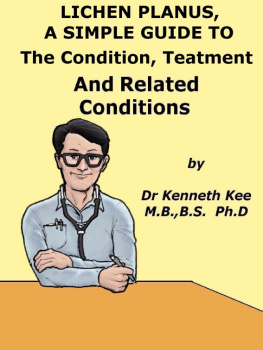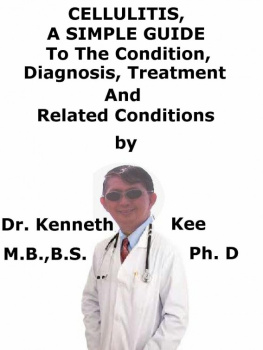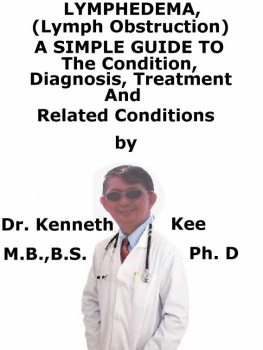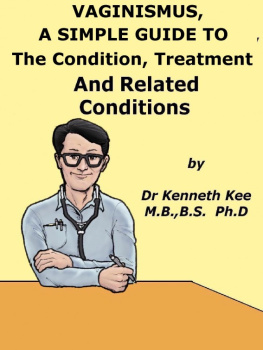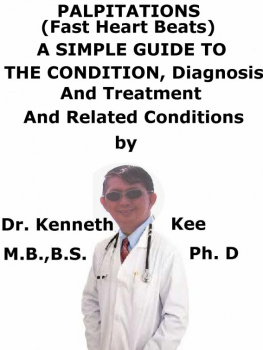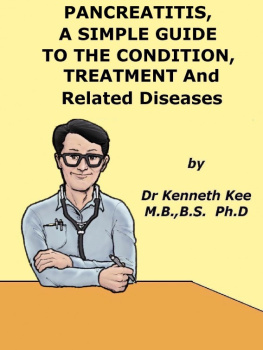Lichen Planus
A
Simple
Guide
To
The Condition,
Treatment
And
Related Conditions
By
Dr Kenneth Kee
M.B.,B.S. (Singapore)
Ph.D (Healthcare Administration)
Copyright Kenneth Kee 2014 SmashwordsEdition
Published by Kenneth Kee atSmashwords.com
Dedication
This book is dedicated
To my wife Dorothy
And my children
Carolyn, Grace
And Kelvin
This book describes the Lichen Planus,Treatment and Associated Diseases or in vernacular terms
(What You Need to Treat Lichen Planus)
This eBook is licensed for the personalenjoyment only. This eBook may not be re-sold or given away toother people. If you would like to share this book with anotherperson, please purchase an additional copy for each reader.
If youre reading this book and did notpurchase it, or it was not purchased for your use only, then pleasereturn to Smashwords.com and purchase your own copy.
Thank you for respecting the hard work ofthis author.
Introduction
Ode To Lichen Planus Lichen Planus is a chronic inflammatorydisease of the skin It consists of red small papules which cancause itch and scratching It is often associated with lesions of themucosal membranes Lichen Planus occurs more in women than inmen The cause of lichen planus may be related toan allergic or immune reaction It is also associated with chronic hepatitisC virus infection The typical rash of Pruritic, Planar, Purple,Polygonal, Papular Microscopic appearance is hyperparakeratosisof the granular cell layer The goal of treatment is to reduce symptomsand speed healing. Dressings placed over skin medicines toprotect from scratching Topical Medicines include topicalcorticosteroids and Vitamin A cream. -An original poem by Kenneth Kee Interesting Tips about the Lichen Planus A Healthy Lifestyle 1. -An original poem by Kenneth Kee Interesting Tips about the Lichen Planus A Healthy Lifestyle 1.
Take a well Balanced Diet 2. Treatment depends on the severity and typeof Lichen Planus. The goal of treatment is to reduce symptomsand speed healing. a. Mild cases may not require anytreatment b. c. c.
Most cases of Lichen Planus lie inbetween. At the present moment there is no known curefor lichen planus. Medicines have been able to reduce theseverity of inflammation and improve the quality of life. a. Topical Medicines include: i. ii. ii.
Vitamin A as a cream (topical retinoicacid) iii. Tar lotions, ointments, creams, andshampoo iv. Other medicines that are applied to theskin such as tacrolimus and pimecroliumus v. Dressings placed over skin medicines toprotect from scratching d. Systemic therapy (oral drugs that affectthe whole body system): Immunosuppressant medications i. Cyclosporine, ii.
Methotrexate iii. Oral retinoid (acitretin) iv. Oral corticosteroids (such as prednisone)to reduce swelling and lower immune responses Corticosteroids shots into a sore v. Hydroxychloroquine vi. Tacrolimus vii. Dapsone e.
Phototherapy (with ultraviolet B, psoralenwith ultraviolet A, radiation) f. Combined therapy is frequently used. g. New therapies such as the biologic agentshas improved the condition h. Antihistamines for itch 3. Keep bones and body strong Bone marrow produces our blood Eat foods rich in calcium like yogurt,cheese, milk, and dark green vegetables.
Eat foods rich in Vitamin D, like eggs, fattyfish, cereal, and fortified milk. Eat food rich in Vitamins B and C such asgreen vegetables and fruits Zinc and other minerals are important to thebody 4. Get enough rest and Sleep Avoid stress and tension 5. Exercise and stay active. It is best to do weight-bearing exercise suchas walking, jogging, stair climbing, dancing, or lifting weightsfor 2 hours a week. One way to do this is to be active 30 minutesa day at least 5 days a week.
Begin slowly especially if a person has notbeen active. 6. Do not drink more than 2 alcohol drinks aday for a man or 1 alcohol drink a day for a woman. Alcohol use also increases the chance offalling and breaking a bone. Alcohol can affect the neurons and braincells. 7.
Stop or do not begin smoking. It also interferes with blood supply andhealing.
Chapter 1
Lichen Planus What is Lichen Planus? Lichen Planus is a chronic inflammatorydisease of the skin which typically consists of red small papulesthat joined together to from rough scaly patches. Lichen planus is a condition that forms anitchy rash on the skin or in the mouth It is often associated with lesions of themucosal membranes. What are the types of Lichen Planus? There are 2 main types: 1. Skin Lichen Planus is the most common typeof Lichen Planus.
About 80% of people have red small papulesthat joined together to from rough scaly patches. The skin usually grows very more quickly andis thicker than usual. 2. Mucosal Lichen Planus (small, red papularlesion of the mouth and mucous membranes) Lichen Planus occurs more in females than inmales. It is also more common in the middleaged. It is rare in children What are the causes of Lichen Planus? The cause of Lichen Planus is unknown.
It may be related to an allergic or immunereaction 1. Allergic reactions to medications for highblood pressure (methyl dopa), dyes, and other chemicals (includinggold, antibiotics, arsenic, iodides, chloroquine, quinacrine,quinide, phenothiazines and diuretics.) 2. Chronic hepatitis C virus infection 3. Stress aggravate the condition 4. Allergic reactions to amalgam and goldfilling can cause oral lesions What are the symptoms of Lichen Planus? Onset is sudden or gradual. They may last weeks or months and berecurrent.
Frequently they become chronic. Symptoms Skin rash The typical rash of lichen planus iswell-defined: 1. Pruritic, 2. Planar, 3. Purple, 4. Papular. Papular.
When seen under the microscope the papuleshave characteristic network of white lines (Wickham's striae) a. They are usually found on the inner wrist,legs, torso, or genitals b. They are itchy c. They have even sides (symmetrical) andsharp borders d. They occur in single lesion or clusters,often at the site of skin injury e. They may be covered with thin whitestreaks or scratch marks (called Wickham's striae) f.
They are shiny or scaly looking g. They have a dark, reddish-purple color onthe skin or are gray-white in the mouth h. They may develop blisters or ulcers Lesions are symmetrical, usually on flexorsurfaces of the arm near the wrist and the ankle. Nails are frequently involved with pittingand thinning of the nail plate. Oral lichen planus occurs in 50% ofpatients: Mouth sores a. They may be tender or painful (mild casesmay not cause plain) b.
They are located on the sides of thetongue, inside of the cheek or gums c. They look like blue-white spots or"pimples" d. They form lines in a lacy network e. They gradually increase in size of theaffected area f. They sometimes form painful ulcers Other symptoms: a. Dry mouth b.
Hair loss c. Metallic taste in the mouth d. Ridges in the nails (nailabnormalities) How is Lichen Planus diagnosed? The doctor may make the diagnosis based onthe appearance of the skin or mouth lesions. A skin lesion biopsy or biopsy of a mouthlesion can confirm the diagnosis. Blood tests may be done to rule outhepatitis. 1.
Reticular form - most common rash, occursas white streaks on the mucosa (known as Wickham's striae) orpapules with small raised area. The lesions are present on the gums, thetongue, palate and lips. The lesions are present on both sides of themouth 2. Bullous form - fluid-filled vesicles 3. Erosive form - erythematous (red) areaswhich are ulcerated. This form may become malignant.

